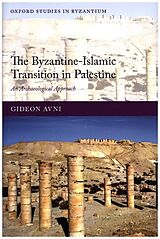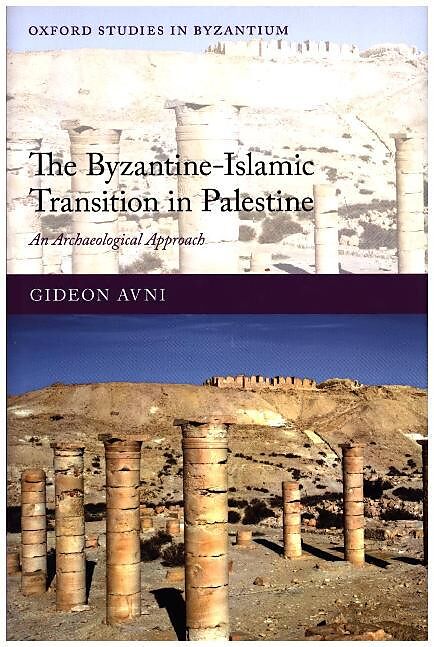The Byzantine-Islamic Transition in Palestine
Einband:
Fester Einband
EAN:
9780199684335
Untertitel:
An Archaeological Approach
Genre:
Geschichte
Autor:
Gideon Avni
Herausgeber:
Oxford Academic
Anzahl Seiten:
442
Erscheinungsdatum:
30.01.2014
ISBN:
978-0-19-968433-5
Zusatztext
In The Byzantine-Islamic Transition in Palestine: An Archeological Approach, Gideon Avni provides a synthesis of current knowledge on the archaeology of Palestine and Jordan in the period from the sixth to eleventh centuries ... Avni provides a huge service to other scholars in bringing together a large amount of recent, specialist material in an accessible format.
Informationen zum Autor
Gideon Avni is the Head of the Archaeological Division in the Israel Antiquities Authority and a lecturer at the Institute of Archaeology at the Hebrew University, Jerusalem. His academic interests focus on various aspects of Classical, Late Antique and Early Islamic archaeology, the cultural and religious transformation of the Near East from Byzantine to Islamic rule, and the archaeology of desert societies in the Levant. He has conducted extensive fieldwork in the Negev Desert, Beth Guvrin, Jerusalem, and Ramla.
Klappentext
Using recent archaeological findings, Avni addresses the transformation of local societies in Palestine and Jordan between the sixth and eleventh centuries AD, arguing that the Byzantine-Islamic transition was a much slower and gradual process than previously thought.
Zusammenfassung
Using recent archaeological findings, Avni addresses the transformation of local societies in Palestine and Jordan between the sixth and eleventh centuries AD, arguing that the Byzantine-Islamic transition was a much slower and gradual process than previously thought.
Inhaltsverzeichnis
LIST OF ILLUSTRATIONS ; PREFACE AND ACKNOWLEDGEMENTS ; PROLOGUE FOUR EYEWITNESS ACCOUNTS VERSUS 'ARGUMENTS IN STONE' ; 1. Shifting Paradigms for the Byzantine: Islamic Transition ; 2. From Polis to Madina: The Evolution of Large Urban Communities ; 3. A Tale of Two Cities: Jerusalem and Ramla in the Early Islamic Period ; 4. The Changing Land: Settlement Patterns and Ethnic Identities ; 5. The Transformation of Settlement and Society: A Synthesis ; 6. Conclusion ; APPENDIX I: CITIES IN BYZANTINE PALESTINE, PHOENICE, AND ARABIA ; APPENDIX II: EARLY ISLAMIC SETTLEMENTS IN PALESTINE AND JORDAN ; APPENDIX III: REGIONAL SURVEYS BYZANTINE AND EARLY ISLAMIC SITES ; BIBLIOGRAPHY ; INDEX
...
In The Byzantine-Islamic Transition in Palestine: An Archeological Approach, Gideon Avni provides a synthesis of current knowledge on the archaeology of Palestine and Jordan in the period from the sixth to eleventh centuries ... Avni provides a huge service to other scholars in bringing together a large amount of recent, specialist material in an accessible format.
Autorentext
Gideon Avni is the Head of the Archaeological Division in the Israel Antiquities Authority and a lecturer at the Institute of Archaeology at the Hebrew University, Jerusalem. His academic interests focus on various aspects of Classical, Late Antique and Early Islamic archaeology, the cultural and religious transformation of the Near East from Byzantine to Islamic rule, and the archaeology of desert societies in the Levant. He has conducted extensive fieldwork in the Negev Desert, Beth Guvrin, Jerusalem, and Ramla.
Klappentext
Using recent archaeological findings, Avni addresses the transformation of local societies in Palestine and Jordan between the sixth and eleventh centuries AD, arguing that the Byzantine-Islamic transition was a much slower and gradual process than previously thought.
Zusammenfassung
Using a comprehensive evaluation of recent archaeological findings, Avni addresses the transformation of local societies in Palestine and Jordan between the sixth and eleventh centuries AD. Arguing that these archaeological findings provide a reliable, though complex, picture, Avni illustrates how the Byzantine-Islamic transition was a much slower and gradual process than previously thought, and that it involved regional variability, different types of populations, and diverse settlement patterns. Based on the results of hundreds of excavations, including Avni's own surveys and excavations in the Negev, Beth Guvrin, Jerusalem, and Ramla, the volume reconstructs patterns of continuity and change in settlements during this turbulent period, evaluating the process of change in a dynamic multicultural society and showing that the coming of Islam had no direct effect on settlement patterns and material culture of the local population. The change in settlement, stemming from internal processes rather than from external political powers, culminated gradually during the Early Islamic period. However, the process of Islamization was slow, and by the eve of the Crusader period Christianity still had an overwhelming majority in Palestine and Jordan.
Inhalt
List of Illustrations
Preface and Acknowledgements
Prologue Four Eyewitness Accounts versus 'Arguments in Stone'
1: Shifting Paradigms for the Byzantine: Islamic Transition
2: From Polis to Madina: The Evolution of Large Urban Communities
3: A Tale of Two Cities: Jerusalem and Ramla in the Early Islamic Period
4: The Changing Land: Settlement Patterns and Ethnic Identities
5: The Transformation of Settlement and Society: A Synthesis
6: Conclusion
Appendix I: Cities in Byzantine Palestine, Phoenice, and Arabia
Appendix II: Early Islamic Settlements in Palestine and Jordan
Appendix III: Regional Surveys Byzantine and Early Islamic Sites
Bibliography
Index

Leider konnten wir für diesen Artikel keine Preise ermitteln ...
billigbuch.ch sucht jetzt für Sie die besten Angebote ...
Die aktuellen Verkaufspreise von 6 Onlineshops werden in Realtime abgefragt.
Sie können das gewünschte Produkt anschliessend direkt beim Anbieter Ihrer Wahl bestellen.
Loading...
Die aktuellen Verkaufspreise von 6 Onlineshops werden in Realtime abgefragt.
Sie können das gewünschte Produkt anschliessend direkt beim Anbieter Ihrer Wahl bestellen.
| # | Onlineshop | Preis CHF | Versand CHF | Total CHF | ||
|---|---|---|---|---|---|---|
| 1 | Seller | 0.00 | 0.00 | 0.00 |
